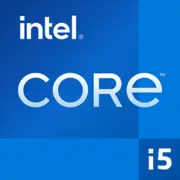Intel Core i5-12490F

Intel Core i5-12490F: Comprehensive Review of the 2025 Processor
March 2025
1. Key Specifications: Architecture, Process Technology, and Key Features
The Intel Core i5-12490F processor belongs to the Alder Lake generation (12th Gen), which was released at the end of 2022 but remains relevant in 2025 due to its successful balance of price and performance.
Architecture and Process Technology
- Hybrid Architecture: Combines Performance-cores (P-cores) and Efficient-cores (E-cores). However, the i5-12490F features only 6 P-cores (12 threads), making it a “pure” six-core CPU without a hybrid scheme.
- Process Technology: Intel 7 (10 nm Enhanced SuperFin).
- Frequencies: Base — 3.0 GHz, maximum in turbo mode — 4.6 GHz.
- Cache: 20 MB L3, which enhances responsiveness in gaming and multitasking.
- TDP: 65 W — energy efficiency on par with office PCs.
Performance
- Geekbench 6: 2782 (single-core), 12192 (multi-core). This is higher than the Ryzen 5 5600X, but slightly lower than the Ryzen 5 7600.
- Features: No integrated graphics (indicated by the “F”), supports PCIe 5.0 (16 lanes).
Practical Example: In games such as Cyberpunk 2077 (2023) at Full HD and medium settings, the CPU provides stable 120+ FPS when paired with a GPU like the RTX 4060.
2. Compatible Motherboards: Sockets and Chipsets
The processor uses the LGA 1700 socket, supported by motherboards with the following chipsets:
- H610: Budget option for basic builds (no overclocking, PCIe 5.0). Example: ASUS Prime H610M-E ($90–$110).
- B660/B760: Optimal choice for most users. Supports PCIe 5.0, memory overclocking. Example: MSI MAG B760 Tomahawk ($150–$170).
- Z690/Z790: For enthusiasts (CPU overclocking, more ports). Example: Gigabyte Z790 Aorus Elite AX ($220–$250).
Tip: If you're not planning to upgrade to 13th Gen Intel, a B660 motherboard will suffice. For DDR5 and PCIe 5.0, choose Z790.
3. Memory Support: DDR4 vs DDR5
The processor works with both types of memory, but the choice depends on the motherboard:
- DDR4-3200: Cheaper (32 GB Kit — $70–$90), suitable for gaming and office tasks.
- DDR5-4800/5200: More expensive (32 GB Kit — $110–$140), but offers a 5–10% performance gain in workstation applications (rendering, encoding).
Recommendation: For gaming with a GPU level of RTX 4070 and lower, the difference between DDR4 and DDR5 is negligible. Opt for DDR4 to save costs.
4. Power Supply: Power Calculation
With a TDP of 65 W, the processor is modest in power consumption, but it’s important to consider the GPU:
- Minimum: 500 W (for RTX 4060 or RX 7600).
- Recommended: 650 W (with headroom for upgrades).
- Certification: 80 Plus Bronze or higher (e.g., Corsair CX650M — $75).
Important: Cheap power supplies may operate unstably under peak loads (e.g., in games with RTX 4080).
5. Pros and Cons of i5-12490F
Pros
- High single-threaded performance (gaming, office tasks).
- Low power consumption and heat output.
- Supports PCIe 5.0 and DDR5.
- Price: $160–$180 (new, 2025).
Cons
- No integrated graphics — a discrete GPU is required.
- No overclocking support (except with Z-series chipsets).
- Falls short against Ryzen 5 7600 in multi-threaded scenarios.
6. Usage Scenarios
- Gaming: Ideal for Full HD/1440p. In conjunction with RTX 4060 Ti or RX 7700 XT, it can handle Alan Wake 2 (2023) at high settings.
- Work Tasks: Video editing in DaVinci Resolve, 3D modeling in Blender (for professional rendering, an i7 or Ryzen 7 would be better).
- Multimedia: Streaming via OBS without lag thanks to 12 threads.
7. Comparison with Competitors
- AMD Ryzen 5 7600: 10–15% faster in multi-threaded tasks but more expensive ($220–$240). Requires DDR5 and AM5 motherboard.
- Intel Core i5-13400F: Features hybrid cores (6P+4E) but lags in frequencies (4.6 vs 4.8 GHz). Similar price.
- Ryzen 5 5600: Outdated AM4 platform, but cheaper ($130). Underperforms in single-threaded tests.
Conclusion: The i5-12490F excels in the budget gaming segment compared to its competitors.
8. PC Building Tips
- Cooler: The stock cooler is sufficient, but for quieter operation, consider an air cooler (DeepCool AK400 — $35).
- Case: Ensure good ventilation (Lian Li Lancool 216 — $90).
- Storage: An NVMe SSD is essential (Samsung 980 1TB — $80).
- BIOS: Some H610/B660 boards may require an update before CPU installation.
9. Final Verdict: Who Should Consider the i5-12490F?
This processor is an excellent choice for:
- Gamers with a budget under $1000 focused on Full HD/1440p.
- Office users needing speed in browsing and Excel.
- Streamers combining gaming and streaming.
Why choose it? For $160–$180, you get a CPU that won’t become obsolete in three years, pairs easily with modern GPUs, and doesn’t require an expensive cooling solution. The main drawback — lack of iGPU — is offset by the availability of budget GPUs (e.g., Intel Arc A580 — $180).
Conclusion: The Intel Core i5-12490F remains a "dark horse" of 2025, especially for those seeking reliability without overspending. It is worth considering if you are not chasing top-tier multi-threaded performance but want to game and work comfortably.
Basic
CPU Specifications
Memory Specifications
GPU Specifications
Miscellaneous
Benchmarks
Compared to Other CPU
Share in social media
Or Link To Us
<a href="https://cputronic.com/cpu/intel-core-i5-12490f" target="_blank">Intel Core i5-12490F</a>